An official website of the United States government
 United States Department of Labor
United States Department of Labor
Teach courses in health specialties, in fields such as dentistry, laboratory technology, medicine, pharmacy, public health, therapy, and veterinary medicine. Excludes “Biological Science Teachers, Postsecondary” (25-1042) and “Nursing Instructors and Teachers, Postsecondary” (25-1072) who teach medical science.
Employment estimate and mean wage estimates for Health Specialties Teachers, Postsecondary:
| Employment (1) | Employment RSE (3) |
Mean hourly wage |
Mean annual wage (2) |
Mean wage RSE (3) |
|---|---|---|---|---|
| 191,830 | 0.7 % | (4) | $ 133,310 | 0.4 % |
Percentile wage estimates for Health Specialties Teachers, Postsecondary:
| Percentile | 10% | 25% | 50% (Median) |
75% | 90% |
|---|---|---|---|---|---|
| Annual Wage (2) | $ 48,890 | $ 64,630 | $ 102,720 | $ 172,680 | (5) |
Industries with the highest published employment and wages for Health Specialties Teachers, Postsecondary are provided. For a list of all industries with employment in Health Specialties Teachers, Postsecondary, see the Create Customized Tables function.
Industries with the highest levels of employment in Health Specialties Teachers, Postsecondary:
| Industry | Employment (1) | Percent of industry employment | Hourly mean wage | Annual mean wage (2) |
|---|---|---|---|---|
| Colleges, Universities, and Professional Schools | 156,320 | 5.24 | (4) | $ 136,970 |
| Junior Colleges | 20,230 | 3.26 | (4) | $ 80,000 |
| General Medical and Surgical Hospitals | 8,530 | 0.15 | (4) | $ 189,850 |
| Technical and Trade Schools | 2,150 | 1.65 | (4) | $ 60,560 |
| Specialty (except Psychiatric and Substance Abuse) Hospitals | 2,040 | 0.75 | (4) | $ 234,730 |
Industries with the highest concentration of employment in Health Specialties Teachers, Postsecondary:
| Industry | Employment (1) | Percent of industry employment | Hourly mean wage | Annual mean wage (2) |
|---|---|---|---|---|
| Colleges, Universities, and Professional Schools | 156,320 | 5.24 | (4) | $ 136,970 |
| Junior Colleges | 20,230 | 3.26 | (4) | $ 80,000 |
| Technical and Trade Schools | 2,150 | 1.65 | (4) | $ 60,560 |
| Specialty (except Psychiatric and Substance Abuse) Hospitals | 2,040 | 0.75 | (4) | $ 234,730 |
| General Medical and Surgical Hospitals | 8,530 | 0.15 | (4) | $ 189,850 |
Top paying industries for Health Specialties Teachers, Postsecondary:
| Industry | Employment (1) | Percent of industry employment | Hourly mean wage | Annual mean wage (2) |
|---|---|---|---|---|
| Specialty (except Psychiatric and Substance Abuse) Hospitals | 2,040 | 0.75 | (4) | $ 234,730 |
| General Medical and Surgical Hospitals | 8,530 | 0.15 | (4) | $ 189,850 |
| Colleges, Universities, and Professional Schools | 156,320 | 5.24 | (4) | $ 136,970 |
| Other Schools and Instruction | 290 | 0.07 | (4) | $ 83,260 |
| Junior Colleges | 20,230 | 3.26 | (4) | $ 80,000 |
States and areas with the highest published employment, location quotients, and wages for Health Specialties Teachers, Postsecondary are provided. For a list of all areas with employment in Health Specialties Teachers, Postsecondary, see the Create Customized Tables function.
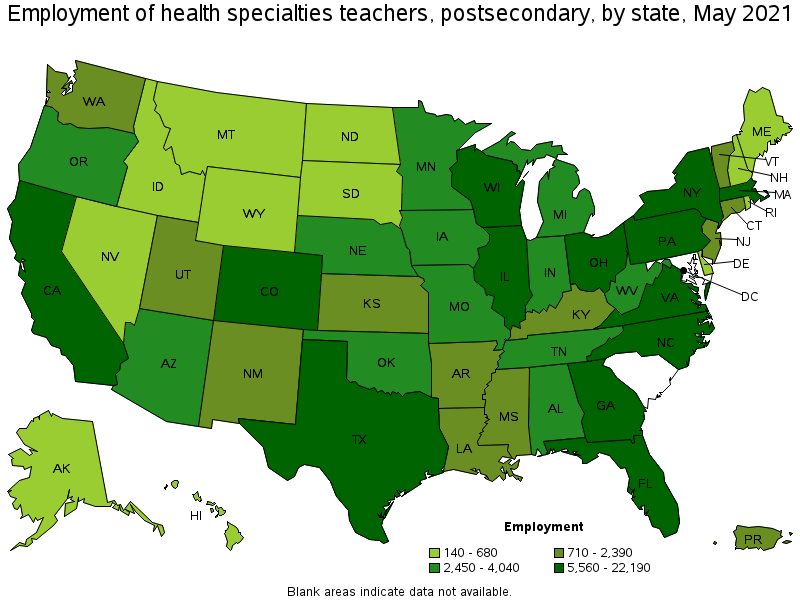
States with the highest employment level in Health Specialties Teachers, Postsecondary:
| State | Employment (1) | Employment per thousand jobs | Location quotient (9) | Hourly mean wage | Annual mean wage (2) |
|---|---|---|---|---|---|
| Texas | 22,190 | 1.81 | 1.33 | (4) | $ 148,800 |
| New York | 20,040 | 2.31 | 1.70 | (4) | $ 141,200 |
| Pennsylvania | 13,350 | 2.39 | 1.76 | (4) | $ 126,400 |
| North Carolina | 11,150 | 2.52 | 1.85 | (4) | $ 145,830 |
| California | 7,560 | 0.46 | 0.34 | (4) | $ 137,600 |
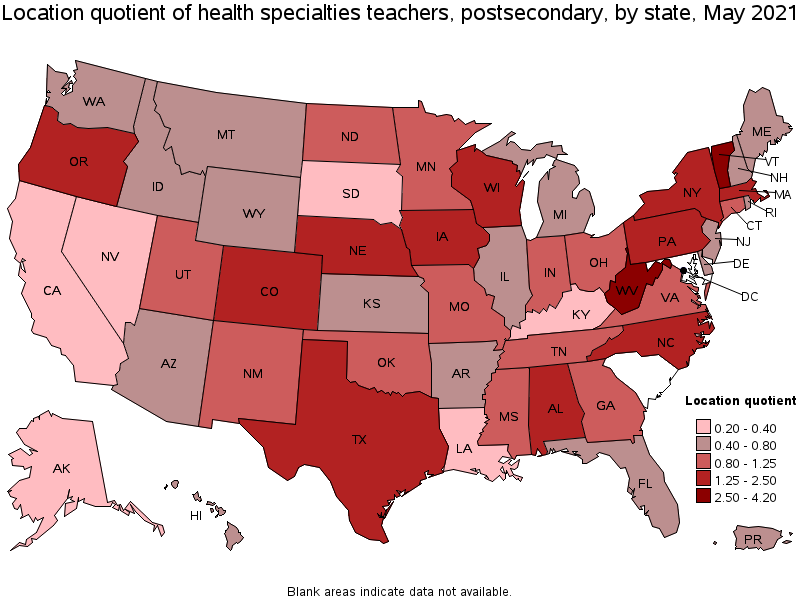
States with the highest concentration of jobs and location quotients in Health Specialties Teachers, Postsecondary:
| State | Employment (1) | Employment per thousand jobs | Location quotient (9) | Hourly mean wage | Annual mean wage (2) |
|---|---|---|---|---|---|
| Vermont | 1,620 | 5.72 | 4.20 | (4) | $ 75,930 |
| West Virginia | 2,640 | 4.01 | 2.95 | (4) | $ 67,260 |
| Nebraska | 2,570 | 2.68 | 1.97 | (4) | $ 88,420 |
| Colorado | 6,770 | 2.58 | 1.90 | (4) | $ 159,270 |
| North Carolina | 11,150 | 2.52 | 1.85 | (4) | $ 145,830 |
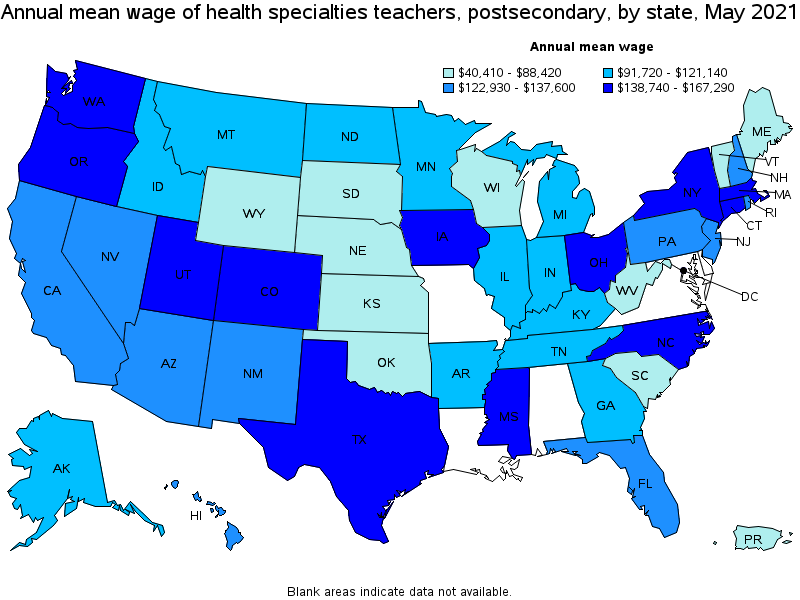
Top paying states for Health Specialties Teachers, Postsecondary:
| State | Employment (1) | Employment per thousand jobs | Location quotient (9) | Hourly mean wage | Annual mean wage (2) |
|---|---|---|---|---|---|
| Washington | 2,150 | 0.67 | 0.49 | (4) | $ 167,290 |
| Mississippi | 1,750 | 1.59 | 1.17 | (4) | $ 163,160 |
| Connecticut | 1,890 | 1.20 | 0.88 | (4) | $ 162,240 |
| Colorado | 6,770 | 2.58 | 1.90 | (4) | $ 159,270 |
| Oregon | 4,040 | 2.21 | 1.63 | (4) | $ 158,080 |
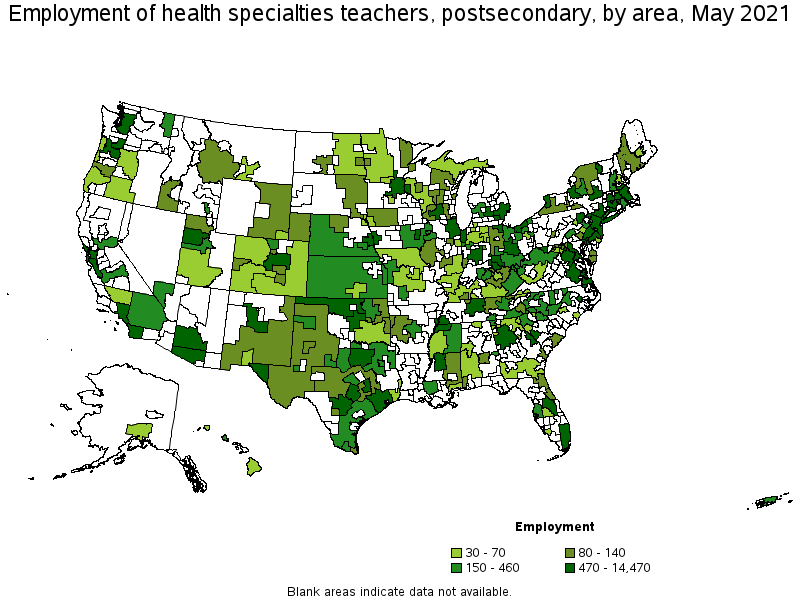
Metropolitan areas with the highest employment level in Health Specialties Teachers, Postsecondary:
| Metropolitan area | Employment (1) | Employment per thousand jobs | Location quotient (9) | Hourly mean wage | Annual mean wage (2) |
|---|---|---|---|---|---|
| New York-Newark-Jersey City, NY-NJ-PA | 14,470 | 1.67 | 1.22 | (4) | $ 145,270 |
| Philadelphia-Camden-Wilmington, PA-NJ-DE-MD | 8,180 | 3.08 | 2.26 | (4) | $ 132,530 |
| Houston-The Woodlands-Sugar Land, TX | 7,340 | 2.53 | 1.86 | (4) | $ 177,780 |
| Dallas-Fort Worth-Arlington, TX | 5,770 | 1.61 | 1.18 | (4) | $ 172,760 |
| Denver-Aurora-Lakewood, CO | 5,650 | 3.85 | 2.83 | (4) | $ 172,540 |
| Boston-Cambridge-Nashua, MA-NH | 4,760 | 1.84 | 1.35 | (4) | $ 157,460 |
| Chicago-Naperville-Elgin, IL-IN-WI | 4,250 | 1.00 | 0.74 | (4) | $ 122,600 |
| Atlanta-Sandy Springs-Roswell, GA | 4,040 | 1.56 | 1.15 | (4) | $ 122,480 |
| Miami-Fort Lauderdale-West Palm Beach, FL | 3,940 | 1.61 | 1.18 | (4) | $ 148,980 |
| Portland-Vancouver-Hillsboro, OR-WA | 3,600 | 3.21 | 2.36 | (4) | $ 166,480 |
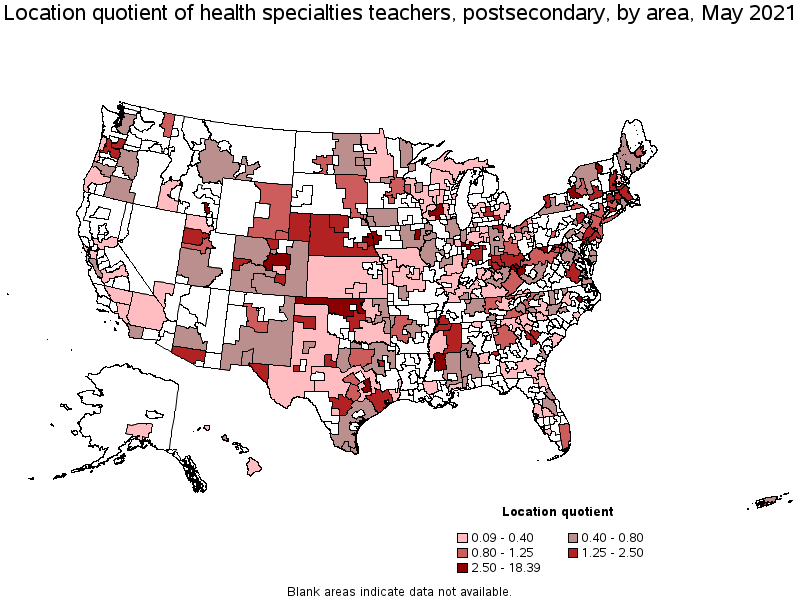
Metropolitan areas with the highest concentration of jobs and location quotients in Health Specialties Teachers, Postsecondary:
| Metropolitan area | Employment (1) | Employment per thousand jobs | Location quotient (9) | Hourly mean wage | Annual mean wage (2) |
|---|---|---|---|---|---|
| Morgantown, WV | 1,560 | 25.04 | 18.39 | (4) | $ 75,260 |
| Iowa City, IA | 1,750 | 20.06 | 14.74 | (4) | $ 173,890 |
| Greenville, NC | 980 | 13.00 | 9.54 | (4) | $ 144,590 |
| Burlington-South Burlington, VT | 1,340 | 11.68 | 8.58 | (4) | $ 71,190 |
| College Station-Bryan, TX | 1,290 | 11.34 | 8.33 | (4) | $ 138,520 |
| Madison, WI | 3,040 | 8.05 | 5.91 | (4) | $ 82,450 |
| Pocatello, ID | 240 | 6.97 | 5.12 | (4) | $ 81,760 |
| Syracuse, NY | 1,590 | 5.69 | 4.18 | (4) | $ 84,370 |
| Denver-Aurora-Lakewood, CO | 5,650 | 3.85 | 2.83 | (4) | $ 172,540 |
| Jackson, MS | 930 | 3.82 | 2.80 | (4) | $ 202,690 |
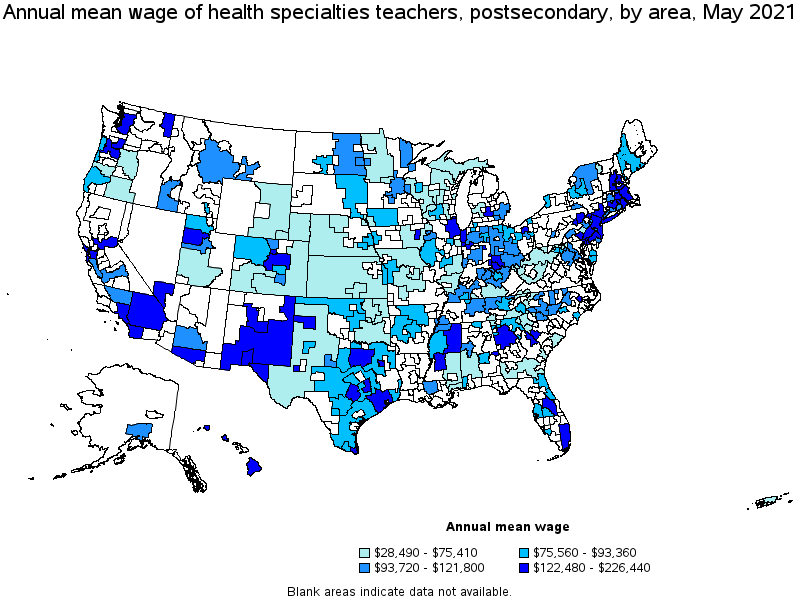
Top paying metropolitan areas for Health Specialties Teachers, Postsecondary:
| Metropolitan area | Employment (1) | Employment per thousand jobs | Location quotient (9) | Hourly mean wage | Annual mean wage (2) |
|---|---|---|---|---|---|
| Hartford-West Hartford-East Hartford, CT | 840 | 1.55 | 1.14 | (4) | $ 226,440 |
| Jackson, MS | 930 | 3.82 | 2.80 | (4) | $ 202,690 |
| Sacramento--Roseville--Arden-Arcade, CA | 450 | 0.46 | 0.34 | (4) | $ 183,250 |
| Houston-The Woodlands-Sugar Land, TX | 7,340 | 2.53 | 1.86 | (4) | $ 177,780 |
| Augusta-Richmond County, GA-SC | 710 | 3.18 | 2.34 | (4) | $ 176,340 |
| San Diego-Carlsbad, CA | 960 | 0.69 | 0.51 | (4) | $ 176,220 |
| Seattle-Tacoma-Bellevue, WA | 1,290 | 0.67 | 0.49 | (4) | $ 176,220 |
| Cincinnati, OH-KY-IN | 1,880 | 1.83 | 1.35 | (4) | $ 174,240 |
| Iowa City, IA | 1,750 | 20.06 | 14.74 | (4) | $ 173,890 |
| Dallas-Fort Worth-Arlington, TX | 5,770 | 1.61 | 1.18 | (4) | $ 172,760 |
Nonmetropolitan areas with the highest employment in Health Specialties Teachers, Postsecondary:
| Nonmetropolitan area | Employment (1) | Employment per thousand jobs | Location quotient (9) | Hourly mean wage | Annual mean wage (2) |
|---|---|---|---|---|---|
| Northwest Oklahoma nonmetropolitan area | 610 | 6.61 | 4.86 | (4) | $ 84,600 |
| Northeast Mississippi nonmetropolitan area | 420 | 1.89 | 1.39 | (4) | $ 154,930 |
| South Nebraska nonmetropolitan area | 360 | 2.45 | 1.80 | (4) | $ 74,980 |
| Southern Ohio nonmetropolitan area | 300 | 1.95 | 1.43 | (4) | $ 106,590 |
| North Texas Region of Texas nonmetropolitan area | 270 | 1.00 | 0.73 | (4) | $ 91,610 |
Nonmetropolitan areas with the highest concentration of jobs and location quotients in Health Specialties Teachers, Postsecondary:
| Nonmetropolitan area | Employment (1) | Employment per thousand jobs | Location quotient (9) | Hourly mean wage | Annual mean wage (2) |
|---|---|---|---|---|---|
| Northwest Oklahoma nonmetropolitan area | 610 | 6.61 | 4.86 | (4) | $ 84,600 |
| Northwest Nebraska nonmetropolitan area | 110 | 2.82 | 2.07 | (4) | $ 71,000 |
| West Central-Southwest New Hampshire nonmetropolitan area | 240 | 2.45 | 1.80 | (4) | $ 143,580 |
| South Nebraska nonmetropolitan area | 360 | 2.45 | 1.80 | (4) | $ 74,980 |
| Southern Ohio nonmetropolitan area | 300 | 1.95 | 1.43 | (4) | $ 106,590 |
Top paying nonmetropolitan areas for Health Specialties Teachers, Postsecondary:
| Nonmetropolitan area | Employment (1) | Employment per thousand jobs | Location quotient (9) | Hourly mean wage | Annual mean wage (2) |
|---|---|---|---|---|---|
| Eastern New Mexico nonmetropolitan area | 110 | 0.77 | 0.57 | (4) | $ 165,220 |
| Northeast Mississippi nonmetropolitan area | 420 | 1.89 | 1.39 | (4) | $ 154,930 |
| West Central-Southwest New Hampshire nonmetropolitan area | 240 | 2.45 | 1.80 | (4) | $ 143,580 |
| Central New Hampshire nonmetropolitan area | 30 | 0.38 | 0.28 | (4) | $ 142,110 |
| Hawaii / Kauai nonmetropolitan area | 40 | 0.46 | 0.34 | (4) | $ 130,310 |
These estimates are calculated with data collected from employers in all industry sectors, all metropolitan and nonmetropolitan areas, and all states and the District of Columbia. The top employment and wage figures are provided above. The complete list is available in the downloadable XLS files.
The percentile wage estimate is the value of a wage below which a certain percent of workers fall. The median wage is the 50th percentile wage estimate—50 percent of workers earn less than the median and 50 percent of workers earn more than the median. More about percentile wages.
(1) Estimates for detailed occupations do not sum to the totals because the totals include occupations not shown separately. Estimates do not include self-employed workers.
(2) Annual wages have been calculated by multiplying the hourly mean wage by a "year-round, full-time" hours figure of 2,080 hours; for those occupations where there is not an hourly wage published, the annual wage has been directly calculated from the reported survey data.
(3) The relative standard error (RSE) is a measure of the reliability of a survey statistic. The smaller the relative standard error, the more precise the estimate.
(4) Wages for some occupations that do not generally work year-round, full time, are reported either as hourly wages or annual salaries depending on how they are typically paid.
(5) This wage is equal to or greater than $100.00 per hour or $208,000 per year.
(9) The location quotient is the ratio of the area concentration of occupational employment to the national average concentration. A location quotient greater than one indicates the occupation has a higher share of employment than average, and a location quotient less than one indicates the occupation is less prevalent in the area than average.
Other OEWS estimates and related information:
May 2021 National Occupational Employment and Wage Estimates
May 2021 State Occupational Employment and Wage Estimates
May 2021 Metropolitan and Nonmetropolitan Area Occupational Employment and Wage Estimates
May 2021 National Industry-Specific Occupational Employment and Wage Estimates
Last Modified Date: March 31, 2022